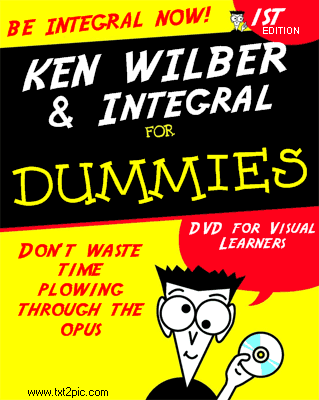
Visit Integral Life, the main outpost for the Ken Wilberian revolution, and see how new age it’s become. (Integral Life is the leader of the deep lifestyle movement, helping people live more free and whole lives using integral philosophy, the first genuine world philosophy for the 21st century. from the site) Having tracked Wilber for 30+ years, I find the uncritical panoply of new ageism to signify Wilberian integralism to have come full circle and returned to its transpersonal, counter-culture, origins.
Wilber and his marketers have been building this brand and its product line for some time. The more developed the brand has become, the more his framework has atrophied. Its almost as if the Wilberian integralists can’t do two things at once. So, I suppose the decision was made. And then the cash registers were installed, and so it has gone.
What it looks like is this: kitschy self-realization resources and pay-to-play products dominating critical culture to the point one can’t find the critical culture anywhere. (How is this not egocentric?)
For example, wrap your discriminating intellect and eros around this:
2012, the Aquarian Age, and the Nature of Evolution (November 19th, 2009 by Darrell Moneyhon)
Regarding Ken’s very valid point addressed in his upcoming book, that indiscriminate democracy could be disastrous, given 70% of the population is at amber or lower, I think I have a solution – a broad strategy that could avert that catastrophe. I call it 3 S, for Sustainable Social Selection. It hinges on the idea that optimal human collective adaptation is based on effective utilization of human resources – no longer on selection via organisms dying off, the old “survival of the fittest” thing.
3 S adapts by finding the right person for the right “assignment”, or “engagement”. “Survival of the fittest is replaced with “survival of the fitting-est” – not meaning that whole groups of individuals (or even organizations or ideologies) will adapt or die from not fitting in with the requirements of the times (although such a selection may occur), but meaning that collectives which are able to get the right persons in the right job will adapt best. The ability to harness the various natural aptitudes and personality orientations, or roughly speaking, “gifts”, is what helps social groups survive and prosper. When the right gifts are placed in the right niches, a kind of workable egalitarianism is formed.
Why? Because gifts will sort out the best thinkers for thinking tasks, the best dreamers/intuiters for creative tasks and early stage innovation, the best relaters for healing and facilitation of social well-being, and the best do-ers for getting projects done in an efficient and effective manner. Those “gift” catagories are mainly types, but line competencies could also be used. Gift-in-niche assignments could be made based on performance (or observed proficiency) on certain lines of development, based on some form of multiple intelligence assessment, etc.. “Gifts” in general could include, then, a blend of type and line “intelligence” – a type-by-line “fit” factor.Because all major types and all kinds (lines) of intelligences would be utilized, productively engaged, and cherished, no gift would be considered higher than other gifts. No gifts would be given better living standards than other gifts. To favor certain gift-sets would violate the very core of the Sustainable Social Selection strategy. All gifts, all people, would be needed in such a strategy. Every one would, therefore be “equal”.
But equal doesn’t mean everyone participates equally in all things. “Each according to her gift” is a 3 S motto. The foot of the collective body does not have the same (equal) access to forks as do the fingers. Nor do the fingers have equal access to shoes. Those would be poor “fits” in a survival-by-the-fitting-est scheme. The understanding and practice of intrinsic power would replace the lust for extensic power. A finger would not want access to shoes (except to help tie shoe laces!), nor would feet want to hold forks. Those “powers” would be extrinsic to the nature of the respective gifts.
Because of the respect given to all the gifts, and because of equal provisions, there would be no press for every person to have equal say in social problem-solving or social planning projects. There would be no advantage or incentive for a do-er to pretend to be a social mapper, etc. If the standard of living is equal, then do-ers would have no incentive to do what they don’t do best! They would naturally prefer practical projects over big-picture pattern analysis, etc.
While I read this, I was thinking to myself, ‘Here’s an old Greek idea!’ Then I get to the point where ‘no gift would be considered higher than other gifts’ is contradicted by this: ‘But equal doesn’t mean everyone participates equally in all things.’ This is garden-variety incoherence. Later, in an addendum, the writer suggests:
The key is get a modified democratic system which gives weighted voting privileges according to gifts, according to the person’s line strengths and/or type. This way, the “fingers” of the collective “body” aren’t voting about shoes. And the”feet” aren’t voting about eating utensiles. A thinker would have, say, one and a half vote, for big picture social policy votes. A relater would have, say, one and a half votes on specific issues related to health care.
The author contributes, by way of contextualizing this suggestion, some thoughts about an assessment regime which would sort out the overt typology of his scheme. Then at the end of his comment he sort of peels away to his core moralism.
But there is no guarantee that the behavior is following an optimal course which is in line with a person’s potential. Accordingly, both individual and collective behavior must be looked at in a dynamic, unfolding, genetic, sort of way, if we are to “behave” ourselves, and to live up to our potential.
Is the author really suggesting that by using typological assessments based in ‘moralized’ categories having to do with capturing in some definitive way a strict monological estimation of individual potential, there could then be a evolutionary progressive integral politics anchored to these behaviorally dispositive moralistic, performative, and structural identities?
The problem of the poverty of critical culture in Wilberian integralism comes to the front in Wilber’s musings.
Here is the idea that the integral world view will be, (or could be,) imposed as a matter of the natural superiority of the second tier moral consciousness. But I have a question, if the integral system hasn’t engendered a critical culture, in what way could I be convinced that second tier moral prescription isn’t, in actuality, massively egocentric, or otherwise darkened?
3. Do I accept that individuals, organizations, and societies must acquire these All Quadrant capacities in a step-by-step or developmental process?
6. Have I, personally, learned “when to hold ’em, and when to fold ’em, and when to walk away?” Can I resist the need to control or engineer people?
9. Can I think systemically by addressing complex issues from a multi-case [multi-cause?] perspective rather than isolate a single culprit.
(2nd Tier, to me, is rigorously self-critical. Obviously this means I’m a charlatan or innovator or heretic.)
So, rather than develop a critical culture able to contest and refine and configure a future integral politics, what has come about is a product line wed to an inchoate “system,” itself born in top down elitism, and wildly over-generalized and simplistic estimations about political behavior. And, these products are tasked with pulling people into this uncritical socio-political sphere; all the while the cash registers ring.
This calls into question the Wilberian Project, almost in-total. One repetitive bit is a pisser in all this: when the second tier maestro, goes about reminding that he or she ‘is not judging,’ or refers to transcend-and-include as a work-around. This may fool people. But, I’m hearing an indelicate mash-up of Plato, Hegel and Mao!
Should one take the blinders off, now, many decades into the Wilberian Project, it is fairly obvious what pseudo-second tier seeks to showcase: an ability to do some educative banking, where you get to buy some old ‘vertical’ thought forms and climb up a little closer. (The idea that a spiritual elite possess the most able political consciousness is especially appealing when one can buy their way in, master the vocabulary, and learn how not to get passionately angry about anything.)
I state this obvious implication of enterprising integral politics with a sense of delighted irony. After all, there isn’t any substantive integral political philosophy–how could there be given what’s being recycled, heck, time shifted! here. And, it is deliciously ironic that Mr. Moneyhon has made an attempt to figure out the ‘assessment’ requirement, since, after all, there isn’t also a substantive integral psychology, let alone an applied integral psychology, upon which to build his mash-up of typology and assessment of aspirational potentials. Of course, with good reason, Centauric political leadership is yoked to integral spirituality, but this sure looks different when there comes the top-down proposal to assess somebody else’s spiritual stage using the potted categories given by integral spirituality.
(Might as well mention, there’s no methodology for doing these assessments; nor is there even a basis for a methodology. It’s a different kind of pipe dream.)
With respect to this latter field, it’s important to point out Wilberian integralism has wed its centralized entrepreneurial focus with (mostly) digital evangelism for its technology of enlightenment. Well, there’s nothing integral about the Wilberian style of commerce.
Full circle we go: how to account for the re-introduction of new age hucksters and thought leaders into the integral mix? What you get with this is a lot of free floating folk metaphysics and magical doctrines, and, above all, you get the utopian ethos built upon a future “Self-developmental” payoff. Cha Ching.
There’s little harm that can come from any of this. When Wilber shifted direction–years ago–and worked to create a marketable new age self-help technology, it became clear the ‘early alpha’ integral analytic framework would either be advanced by others, or, not.
***
Daniel Gustav Anderson has contributed an excellent piece at Integral World, Integral Theory After Wilber. His blog is thought provoking and a favorite.
From his excellent essay, one I take as a beginning:
Integral theory should be critical. By this I mean it should be dialectical; it should be scientific and examined as such, rather than transmitted as a belief-structure or a cult object. Universal and essentializing claims should be eschewed in favor of properly warranted, demonstrated, and delineated ones. If one is inclined to speculate and explore ideas with a freer hand as I myself often do, or when one sees that evidence is lacking for an idea that may reward further investigation, such speculations and ideas should be marked for what they are: explorations, thought experiments, provisional claims, possibilities for future inquiry, or (to borrow from David Lane) an instance of unknowingness. In short, integral theory should be critically self-aware of how it makes knowledge, and how that knowledge functions politically and socially. The Critical Theory of the Frankfurt School has much to offer in this regard, as does the pedagogy of Paulo Freire.
(There’s a lot of integral thinking and writing by persons who knew nothing, may have predated, the Wilberian ‘integral.’ I’ve come to respect greatly the variety of superb descriptive and analytic work which wanders in disciplined ways through various subjective and objective perspectives. On the web, Integral World, provides a portal for post-Wilberian thought–although quality varies a great deal. IW authors )
The spell that binds us today consists not least in the fact that it ceaselessly urges people to take action that they believe will break the spell; and that it prevents the reflection on themselves and the circumstances that might really break it. (Theodore Adorno)


